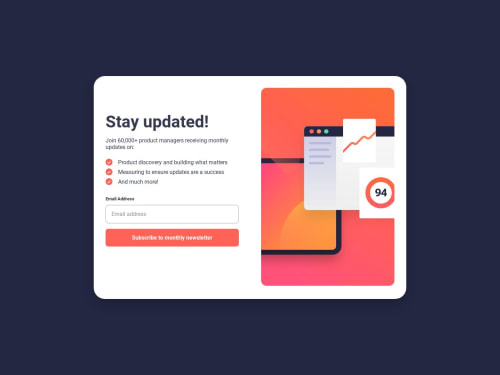Responsive Newsletter signup page using HTML, CSS & JS

Solution retrospective
I am most proud of the attention to detail and the level of care I put into ensuring that the project meets the design specifications and follows best practices for web development. From the semantic HTML structure to the well-organized CSS styles, I aimed to create a codebase that is not only visually appealing but also maintainable and accessible. Additionally, I'm proud of the interactive elements I implemented using JavaScript, such as form validation and hover effects on buttons.
If I were to approach a similar project in the future, I would consider:
Leveraging more advanced JavaScript frameworks or libraries like React or Vue.js to manage complex interactive elements more efficiently. Implementing server-side validation alongside client-side validation to enhance security and provide a seamless user experience.
What challenges did you encounter, and how did you overcome them?One of the challenges I encountered was ensuring that the layout remained consistent and visually appealing across different screen sizes. To overcome this, I utilized CSS techniques such as flexible box layouts, relative units, and media queries to create a responsive design that adapts to various viewport widths.
Another challenge was interpreting the provided design mockup and translating it into code accurately. To address this, I carefully studied the design specifications, paying close attention to details such as typography, spacing, colors, and layout. I also made use of developer tools in the browser to inspect and adjust the styling as needed.
Additionally, I encountered some challenges related to implementing interactive elements using JavaScript. For example, I had to ensure that form validation worked correctly and that hover effects on buttons were consistent across different browsers. To overcome these challenges, I relied on JavaScript event listeners and DOM manipulation techniques, and I thoroughly tested the functionality across various browsers and devices.
What specific areas of your project would you like help with?While I am confident in my HTML, CSS, and JavaScript skills, there are always opportunities for improvement and learning. Specifically, I would appreciate guidance and feedback in the following areas:
Performance Optimization: Techniques and strategies for optimizing the performance of web pages, such as minimizing render-blocking resources, optimizing asset delivery, and implementing performance budgets. Accessibility Testing: Hands-on experience with accessibility testing tools and methodologies to identify and address potential accessibility issues more effectively. JavaScript Best Practices: Recommendations on best practices for writing clean, efficient, and maintainable JavaScript code, especially for managing complex interactive elements and handling user input. Cross-browser Compatibility: Best practices for ensuring consistent cross-browser behavior, especially when it comes to handling browser-specific quirks or implementing fallbacks for older browsers.
Please log in to post a comment
Log in with GitHubCommunity feedback
No feedback yet. Be the first to give feedback on Pritesh Dhandhukia's solution.
Join our Discord community
Join thousands of Frontend Mentor community members taking the challenges, sharing resources, helping each other, and chatting about all things front-end!
Join our Discord